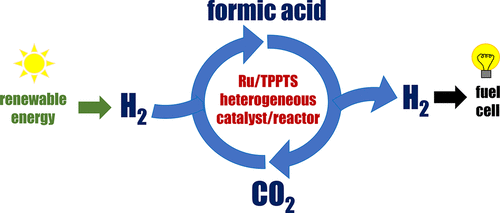当前位置:
X-MOL 学术
›
ACS Sustain. Chem. Eng.
›
论文详情
Our official English website, www.x-mol.net, welcomes your
feedback! (Note: you will need to create a separate account there.)
Heterogeneous Catalytic Reactor for Hydrogen Production from Formic Acid and Its Use in Polymer Electrolyte Fuel Cells
ACS Sustainable Chemistry & Engineering ( IF 7.1 ) Pub Date : 2018-03-22 00:00:00 , DOI: 10.1021/acssuschemeng.8b00423 Igor Yuranov 1, 2 , Nordahl Autissier 2 , Katerina Sordakis 1 , Andrew F. Dalebrook 1 , Martin Grasemann 1 , Vit Orava 3 , Peter Cendula 3 , Lorenz Gubler 4 , Gábor Laurenczy 1
ACS Sustainable Chemistry & Engineering ( IF 7.1 ) Pub Date : 2018-03-22 00:00:00 , DOI: 10.1021/acssuschemeng.8b00423 Igor Yuranov 1, 2 , Nordahl Autissier 2 , Katerina Sordakis 1 , Andrew F. Dalebrook 1 , Martin Grasemann 1 , Vit Orava 3 , Peter Cendula 3 , Lorenz Gubler 4 , Gábor Laurenczy 1
Affiliation

|
A proof-of-concept prototype of a heterogeneous catalytic reactor has been developed for continuous production of hydrogen via formic acid (FA) dehydrogenation. A laboratory-type polymer electrolyte fuel cell (PEFC) fed with the resulting reformate gas stream (H2 + CO2) was applied to convert chemical energy to electricity. To implement an efficient coupling of the reactor and PEFC, research efforts in interrelated areas were undertaken: (1) solid catalyst development and testing for H2 production; (2) computer modeling of heat and mass transfer to optimize the reactor design; (3) study of compatibility of the reformate gas fuel (H2 + CO2) with a PEFC; and (4) elimination of carbon monoxide impurities via preferential oxidation (PROX). During the catalyst development, immobilization of the ruthenium(II)–meta-trisulfonated triphenylphosphine, Ru-mTPPTS, catalyst on different supports was performed, and this complex, supported on phosphinated polystyrene beads, demonstrated the best results. A validated mathematical model of the catalytic reactor with coupled heat transfer, fluid flow, and chemical reactions was proposed for catalyst bed and reactor design. Measured reactor operating data and characteristics were used to refine modeling parameters. In turn, catalyst bed and reactor geometry were optimized during an iterative adaptation of the reactor and model parameters. PEFC operating conditions and fuel gas treatment/purification were optimized to provide the best PEFC efficiency and lifetime. The low CO concentration (below 5 ppm) in the reformate was ensured by a preferential oxidation (PROX) stage. Stable performance of a 100 W PEFC coupled with the developed reactor prototype was successfully demonstrated.
中文翻译:

甲酸制氢的非均相催化反应器及其在聚合物电解质燃料电池中的应用
已经开发出用于通过甲酸(FA)脱氢连续生产氢的非均相催化反应器的概念验证原型。供给了所得重整产物气流(H 2 + CO 2)的实验室型聚合物电解质燃料电池(PEFC )被用于将化学能转化为电能。为了实现反应器和PEFC的有效耦合,在相关领域进行了研究工作:(1)固体催化剂的开发和H 2生产的测试;(2)热与质传递的计算机建模,以优化反应器设计;(3)重整气燃料(H 2 + CO 2)相容性的研究)与PEFC;(4)通过优先氧化(PROX)消除一氧化碳杂质。在催化剂开发过程中,固定化了钌(II)-间-三磺化三苯基膦Ru- m进行了在不同载体上的催化剂TPPTS,并在亚膦酸酯化的聚苯乙烯珠粒上负载的这种络合物显示出最佳的结果。提出了具有耦合传热,流体流动和化学反应的催化反应器的验证数学模型,用于催化剂床和反应器的设计。使用测得的反应堆运行数据和特性来完善建模参数。反过来,在反应器和模型参数的迭代适应过程中,优化了催化剂床和反应器的几何形状。PEFC的运行条件和燃气处理/净化得到了优化,以提供最佳的PEFC效率和使用寿命。通过优先氧化(PROX)阶段确保了重整产品中的低CO浓度(低于5 ppm)。
更新日期:2018-03-22
中文翻译:

甲酸制氢的非均相催化反应器及其在聚合物电解质燃料电池中的应用
已经开发出用于通过甲酸(FA)脱氢连续生产氢的非均相催化反应器的概念验证原型。供给了所得重整产物气流(H 2 + CO 2)的实验室型聚合物电解质燃料电池(PEFC )被用于将化学能转化为电能。为了实现反应器和PEFC的有效耦合,在相关领域进行了研究工作:(1)固体催化剂的开发和H 2生产的测试;(2)热与质传递的计算机建模,以优化反应器设计;(3)重整气燃料(H 2 + CO 2)相容性的研究)与PEFC;(4)通过优先氧化(PROX)消除一氧化碳杂质。在催化剂开发过程中,固定化了钌(II)-间-三磺化三苯基膦Ru- m进行了在不同载体上的催化剂TPPTS,并在亚膦酸酯化的聚苯乙烯珠粒上负载的这种络合物显示出最佳的结果。提出了具有耦合传热,流体流动和化学反应的催化反应器的验证数学模型,用于催化剂床和反应器的设计。使用测得的反应堆运行数据和特性来完善建模参数。反过来,在反应器和模型参数的迭代适应过程中,优化了催化剂床和反应器的几何形状。PEFC的运行条件和燃气处理/净化得到了优化,以提供最佳的PEFC效率和使用寿命。通过优先氧化(PROX)阶段确保了重整产品中的低CO浓度(低于5 ppm)。











































 京公网安备 11010802027423号
京公网安备 11010802027423号